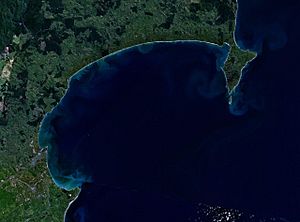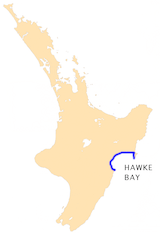Hawke Bay facts for kids
Hawke Bay is a big bay on the eastern side of New Zealand's North Island. It stretches about 100 kilometers (62 miles) along the coast. You can find it between Mahia Peninsula in the north and Cape Kidnappers in the south.
Contents
Discovering Hawke Bay
Captain Cook's Visit
The famous explorer, Captain James Cook, sailed into this bay a long time ago. He arrived on October 12, 1769, aboard his ship, HMS Bark Endeavour. After exploring the area, he named the bay on October 15, 1769. He named it after Sir Edward Hawke. Sir Edward Hawke was a very important naval leader at the time. He had won a big sea battle against the French in 1759.
How the Land Changed
Rising from the Sea
The land around Hawke Bay is always slowly moving upwards. This is because of something called tectonic uplift. It means the Earth's crust is pushing the land higher. Because of this, you can find old sea deposits on the land. Scientists have even found fossils of both sea and land dinosaurs far inland!
The 1931 Earthquake
A powerful earthquake hit this area on February 3, 1931. It is known as the Napier earthquake. This earthquake caused parts of the seabed near the city of Napier to rise above the water. This created new land where the sea used to be.
Exploring the Coastline
Cliffs and Beaches
At the northern end of Hawke Bay, tall mountains come very close to the sea. This has created deeply eroded land that ends in steep cliffs. These cliffs drop down to narrow beaches below. It makes for a very dramatic coastline!
Towns and Rivers
Several towns and cities are located around Hawke Bay. The town of Wairoa is at the northern end of the bay. It sits where the Wairoa River flows into the sea. Further south, you'll find the port city of Napier right on the coast. Near the southern end of the bay is the city of Hastings. It is also on a flat area near a river. The main port in the bay, where ships come and go, is the Port of Napier.
Hawke Bay vs. Hawke's Bay Region
It can be a bit confusing, but there's a difference between Hawke Bay and the Hawke's Bay Region. Hawke Bay refers to the actual body of water itself. The Hawke's Bay region is the land area around the bay. It also includes the land further inland to the south. So, the bay is named Hawke Bay, but the region uses the bay's older name, Hawke's Bay.



